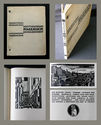
19th, 20th & 21st Century Fine Prints
707-546-7352 · fax 707-546-7924 · web: www.annexgalleries.com · email: artannex@aol.com
Max Thalmann Biography
Max Thalmann
German
1890–1944
Biography
Max Thalmann, artist, illustrator and designer, was born in Rudolstadt, Germany on August 13, 1890. After a bookbinding apprenticeship in Halle in 1909, Thalmann attended the Kunstgewerbeschule Weimar (School of Applied Arts in Weimar), studying under Belgian painter and architect Henry van de Velde and master bookbinder and cover designer Otto Dorfner.
Declared unfit to serve by the Army due to poor health, Thalmann continued his studies in Weimar, enrolling at the Academy of Fine Arts. There he studied under printmaker and painter Walther Klemm; soon, Thalmann began to gain recognition for his work, particularly for his drawings and woodcuts. In 1919 he was employed as “Jungmeister” at the Bauhaus Weimar, which launched him into his career as both a fine artist and self-employed designer.
The 1920s and early 1930s were his most active and successful years as an artist. In 1921 Thalmann created the art folio “Passion,” which would be the beginning of his exploration of the portfolio as an art form in itself. Following this, he published “Der Dom,” a work of classic German Expressionist design, depicting ten stylized abstract images of cathedral interiors. Then, in 1923-24 he traveled to the United States, where he was inspired to create “Rhythms of the New World - America in Woodcut,” which was the last of his published cycles. While visiting his brother in Chicago he held a small exhibition of his works at a local gallery. Thalmann had hopes to move to the U.S., and left his collection with his brother; he was never able to return.
In the 1930s, Thalmann changed his focus from woodcuts to watercolors, drawings, and pastels. A trip to Egypt inspired a series of works, based people’s daily routines and the landscapes that were so different from his own country. By the mid 1930s he settled in Jena, Germany and, with the rise of the Nazi regime, seems to have abandoned much of his Expressionist artistic pursuits, perhaps out of fear of persecution by the new government. He was hired as a book cover designer for Eugen Diedrich’s publishing house and designed over 150 books before his death in Jena on 21 September 1944 shortly before the end of the war.



